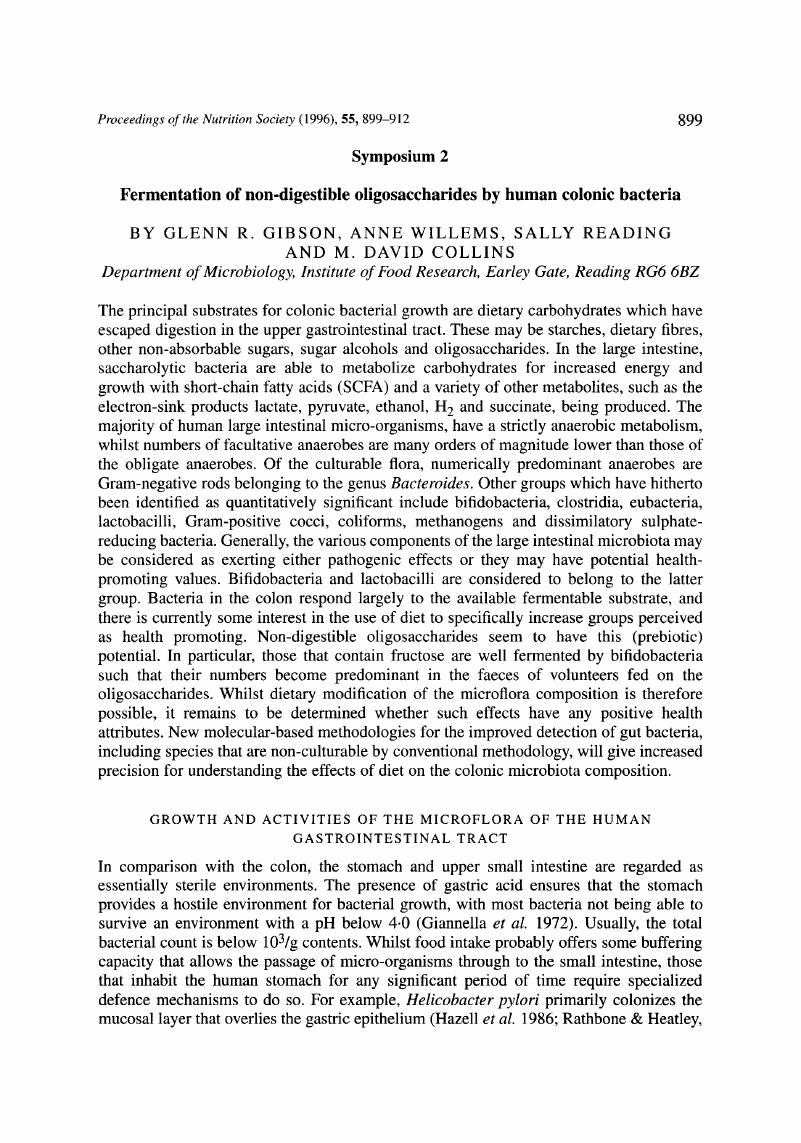Crossref Citations
This article has been cited by the following publications. This list is generated based on data provided by Crossref.
Mela, David J.
1997.
Fat and sugar substitutes: implications for dietary intakes and energy balance.
Proceedings of the Nutrition Society,
Vol. 56,
Issue. 3,
p.
827.
Chaplin, M.F.
1998.
Review : Bile acids, fibre and colon cancer: the story unfolds.
Journal of the Royal Society of Health,
Vol. 118,
Issue. 1,
p.
53.
Martín-Carrón, Nuria
and
Goñi, Isabel
1998.
Prior Exposure of Cecal Microflora to Grape Pomaces Does Not Inhibit in Vitro Fermentation of Pectin.
Journal of Agricultural and Food Chemistry,
Vol. 46,
Issue. 3,
p.
1064.
Willis, Caroline L.
and
Gibson, Glenn R.
1999.
Encyclopedia of Food Microbiology.
p.
1351.
Ames, Jennifer M.
Wynne, Anthony
Hofmann, Andrea
Plos, Saskia
and
Gibson, Glenn R.
1999.
The effect of a model melanoidin mixture on faecal bacterial populationsin vitro.
British Journal of Nutrition,
Vol. 82,
Issue. 6,
p.
489.
Birkbeck, John
1999.
Medical Importance of the Normal Microflora.
p.
262.
Boon, M. A.
van’t Riet, K.
and
Janssen, A. E. M.
2000.
Enzymatic synthesis of oligosaccharides: Product removal during a kinetically controlled reaction.
Biotechnology and Bioengineering,
Vol. 70,
Issue. 4,
p.
411.
Tuohy, Kieran M.
Finlay, Rochelle K.
Wynne, Anthony G.
and
Gibson, Glenn R.
2001.
A Human Volunteer Study on the Prebiotic Effects of HP-Inulin—Faecal Bacteria Enumerated Using Fluorescent In Situ Hybridisation (FISH).
Anaerobe,
Vol. 7,
Issue. 3,
p.
113.
Rycroft, Catherine E.
Rastall, Robert A.
and
Gibson, Glenn R.
2001.
Novel Frontiers in the Production of Compounds for Biomedical Use.
Vol. 1,
Issue. ,
p.
411.
Tuohy, K. M.
Kolida, S.
Lustenberger, A. M.
and
Gibson, G. R.
2001.
The prebiotic effects of biscuits containing partially hydrolysed guar gum and fructo-oligosaccharides – a human volunteer study.
British Journal of Nutrition,
Vol. 86,
Issue. 3,
p.
341.
Zink, Ralf
and
Pfeifer, Andrea
2001.
Ullmann's Encyclopedia of Industrial Chemistry.
BORNET, Francis R.J.
MEFLAH, Khaled
and
MENANTEAU, Jean
2002.
Enhancement of Gut Immune Functions by Short-Chain Fructooligosaccharides and Reduction of Colon Cancer Risk.
Bioscience and Microflora,
Vol. 21,
Issue. 1,
p.
55.
Brouns, Fred
Kettlitz, Bernd
and
Arrigoni, Eva
2002.
Resistant starch and “the butyrate revolution”.
Trends in Food Science & Technology,
Vol. 13,
Issue. 8,
p.
251.
Le Gorrec, Karine
Connes, Cristelle
Guibert, Alain
Uribelarrea, Jean-Louis
and
Combes, Didier
2002.
Identification of three inducible and extracellular enzymatic activities working on sucrose in Bacillus subtilis NCIMB 11871 and 11872 supernatant.
Enzyme and Microbial Technology,
Vol. 31,
Issue. 1-2,
p.
44.
GIBSON, Glenn R.
2002.
Intestinal Microflora Research for the 21st Century.
Bioscience and Microflora,
Vol. 20,
Issue. 4,
p.
131.
2002.
Abstracts of Original Communications.
Proceedings of the Nutrition Society,
Vol. 61,
Issue. 3a,
p.
98A.
Arrigoni, Eva
Jörger, Francisca
Kollöffel, Beat
Roulet, Isabelle
Herensperger, Monique
Meile, Leo
and
Amadò, Renato
2002.
In vitro fermentability of a commercial wheat germ preparation and its impact on the growth of bifidobacteria.
Food Research International,
Vol. 35,
Issue. 5,
p.
475.
Forest, Virginie
Pierre, Fabrice
Bassonga, Euphémie
Meflah, Khaled
Olivier, Christophe
and
Menanteau, Jean
2003.
Apc+/Min colonic epithelial cells express TNF receptors and ICAM-1 when they are co-cultured with large intestine intra-epithelial lymphocytes.
Cellular Immunology,
Vol. 223,
Issue. 1,
p.
70.
Arrigoni, Eva
Brouns, Fred
and
Amadò, Renato
2005.
Human gut microbiota does not ferment erythritol.
British Journal of Nutrition,
Vol. 94,
Issue. 5,
p.
643.
Cowieson, A. J
Hruby, M
and
Pierson, E. E. M
2006.
Evolving enzyme technology: impact on commercial poultry nutrition.
Nutrition Research Reviews,
Vol. 19,
Issue. 1,
p.
90.



